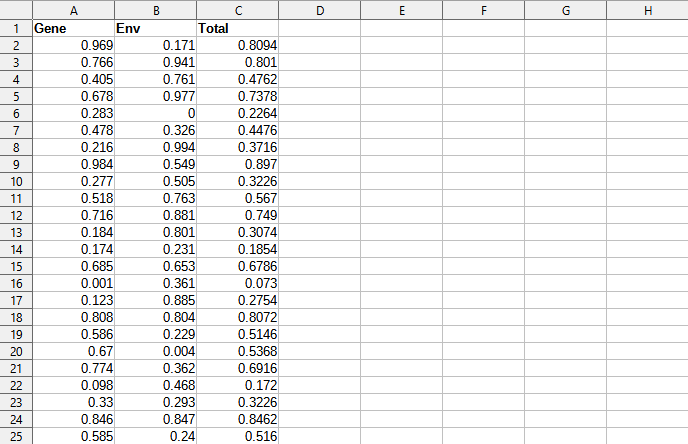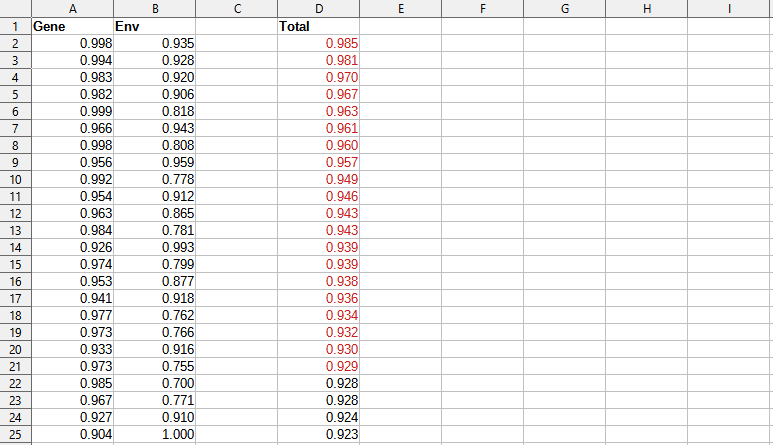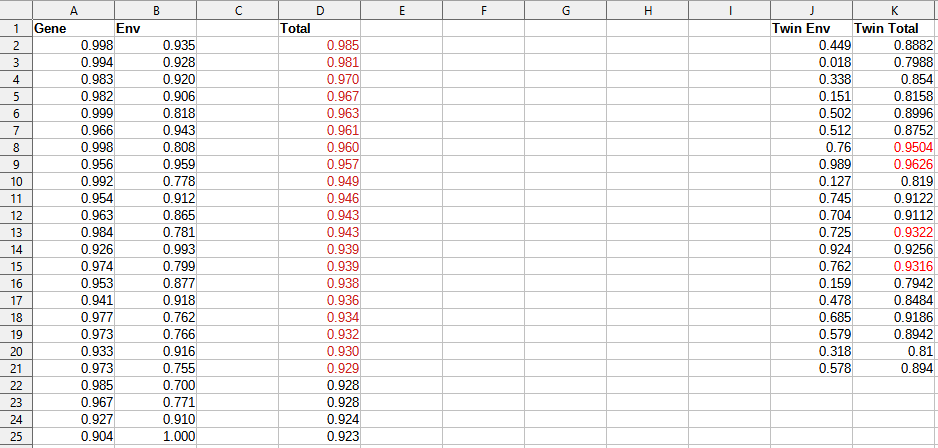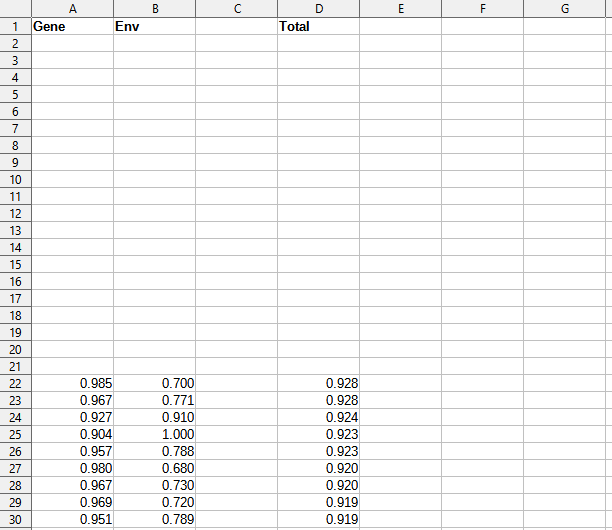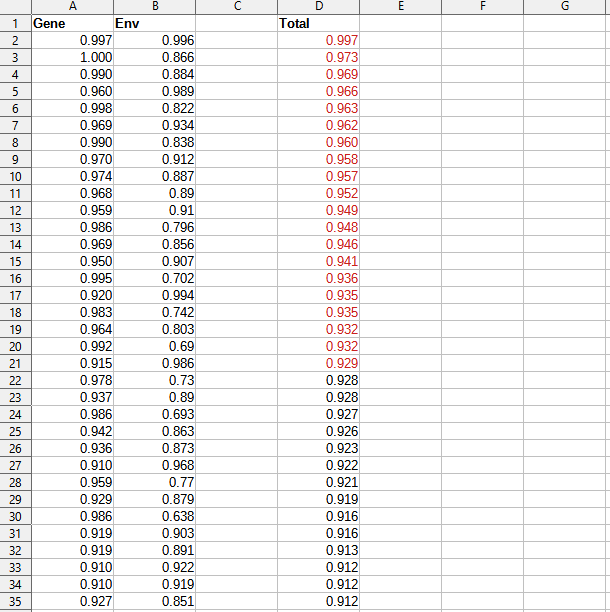Some Unintuitive Properties Of Polygenic Disorders
E. Fuller Torrey recently published a journal article trying to cast doubt on the commonly-accepted claim that schizophrenia is mostly genetic. Most of his points were the usual misunderstanding of polygenic diseases - there’s no single gene that causes all of it, so it must be environmental! - but two arguments stood out:
I used to find arguments like these convincing, but since I’ve learned more about genetics they no longer have such a hold on me. I’m going to try to communicate my reasoning with a very simple simulation, then give links to people who do the much more complicated math that it would take to model the real world. Let’s start with the identical twin concordance. If you have schizophrenia, there’s only a 15% - 50% chance your identical twin has it too. Does that really fit a condition which is supposedly 80% genetic? Shouldn’t it be an 80% chance? Or at least higher than 15%? No. I ran a discount-rate simulation on a spreadsheet. I generated 2000 people. I gave each of them a genetic risk score and an environmental risk score - both random numbers between 0 and 1. Then I created a total risk score which was the average of their genetic and environmental scores, with the genetic weighted 4x more highly than the environmental, ie [((4 * genetic) + (environmental))/5]. In other words, the genetic score contributed 80% of the variance. It looked like this. Since 1% of the population is schizophrenic, I sorted by total risk score and declared the top 20 out of these 2000 people to be schizophrenics. This produced a threshold of 0.928 - in this discount simulation, anyone with a higher total risk score than that got the condition. Then I generated a “twin” for each schizophrenic: another person who had the same genetic risk score, but a new random environmental risk score. I computed total risk score [((4 * genetic) + (environmental))/5] for the second twin. We see here that only four of the twenty twins pass the 0.928 threshold for schizophrenia - a 20% rate. This fits well within the 15% - 50% rate we find in real life. Since our simulation says genes matter 4x more than environment, how come the identical twins of schizophrenics (who have the same genes) are so unlikely to have the condition? Look at the screenshot above again, and notice the genetic and environmental risk scores of the original twenty schizophrenics. By sorting for total risk, we select very heavily on genetic risk, which matters four times more - and so we see numbers like 0.998, 0.994, 0.983, etc. But we’re still selecting somewhat on environmental risk, so we see numbers like 0.935, 0.928, and 0.920 (remember, average is 0.5). Schizophrenia is so rare that you need both high genetic and high environmental risk to get it. Now go to the twins. By definition, they also have high genetic risk scores. But on average, they have average environmental risk scores. Most of them don’t cross the 0.928 threshold unless the random number generator that determined their environmental risk score came up high. How high? In this simulation it had to be at least 0.725. Only about a quarter of people score that high, and in this simulation the exact number was 20%. Is it wrong to give twins random environmental scores? Don’t twin pairs grow up in very similar environments? Yes - this is why I called this an overly simplified simulation that was just supposed to communicate the basic point. ACX commenter Metacelsus found a paper from 1970 that did the full calculations and predicts about 33% twin concordance for a disease like schizophrenia with 80% heritability and 1% prevalence. But I think even this isn’t exactly right; it depends on the balance between shared and non-shared environmental risks. Still, somewhere in the 15 - 50% range is probably reasonable. What about the second argument, the one about the Nazis’ eugenics program? Here I took the same simulation and eliminated all the schizophrenics: Making everyone mate is beyond the scope of this discount-rate simulation, so I just assumed everyone had a child who had the exact same genetic risk as themselves, but a new random environmental risk. Then I sorted again, and called anyone with total risk > 0.928 a schizophrenic. The new generation still has 20 schizophrenics - just as many as the last! How can this be? The lowest genetic risk score of a person who nevertheless developed schizophrenia was 0.915. In our sample of 2000 people, we should expect about 183 people to be at or above that threshold. The simulated Nazis killed off 20 in the last generation. There are still 163 left. These are people who didn’t have schizophrenia because they had a positive environment, but could have had it if their environment was worse. They outnumber schizophrenics by almost 10 to 1. Then we bring their genes forward into the new generation, some of them get bad environments, and they get schizophrenia. I think you should expect very slightly fewer schizophrenics in the new generation, but the effect size wasn’t noticeable in this small granular simulation - nor, apparently, in Germany. I can’t find a formal paper about this one. A better model would have to take into account that people’s children aren’t clones of themselves, and that children’s environment is correlated with their parents’. But both of these would drive schizophrenia rates up, not down, so I think this makes the point just fine. People really hate the finding that most diseases are substantially (often primarily) genetic. There’s a whole toolbox that people in denial about this use to sow doubt. Usually it involves misunderstanding polygenicity/omnigenicity, or confusing GWAS’ current inability to detect a gene with the gene not existing. I would have hoped E. Fuller Torrey, a giant of schizophrenia research, was above this kind of thing. But apparently it happens to the best of us. The two arguments above were the really novel ones that I found potentially convincing. But AFAlCT the mystery goes away once you think about them more formally. Awais Aftab has a more interesting article about how even if the twin studies are right, “mostly genetic” is a poor way to describe their results. I disagree, and will try to respond to it some other time. You're currently a free subscriber to Astral Codex Ten. For the full experience, upgrade your subscription. |
Older messages
Should The Future Be Human?
Tuesday, January 23, 2024
Machine Alignment Monday 1/22/24
Open Thread 312
Monday, January 22, 2024
...
Subscrive Drive 2024 + Free Unlocked Posts
Thursday, January 18, 2024
...
Links For January 2024
Thursday, January 18, 2024
...
Against Learning From Dramatic Events
Tuesday, January 16, 2024
...
You Might Also Like
☕ Chance of clouds
Sunday, March 9, 2025
What is the future of weather forecasting? March 09, 2025 View Online | Sign Up | Shop Morning Brew Presented By Fatty15 Takashi Aoyama/Getty Images BROWSING Classifieds banner image The wackiest
Federal Leakers, Egg Investigations, and the Toughest Tongue Twister
Sunday, March 9, 2025
Homeland Security Secretary Kristi Noem said Friday that DHS has identified two “criminal leakers” within its ranks and will refer them to the Department of Justice for felony prosecutions. ͏ ͏ ͏
Strategic Bitcoin Reserve And Digital Asset Stockpile | White House Crypto Summit
Saturday, March 8, 2025
Trump's new executive order mandates a comprehensive accounting of federal digital asset holdings. Forbes START INVESTING • Newsletters • MyForbes Presented by Nina Bambysheva Staff Writer, Forbes
Researchers rally for science in Seattle | Rad Power Bikes CEO departs
Saturday, March 8, 2025
What Alexa+ means for Amazon and its users ADVERTISEMENT GeekWire SPONSOR MESSAGE: Revisit defining moments, explore new challenges, and get a glimpse into what lies ahead for one of the world's
Survived Current
Saturday, March 8, 2025
Today, enjoy our audio and video picks Survived Current By Caroline Crampton • 8 Mar 2025 View in browser View in browser The full Browser recommends five articles, a video and a podcast. Today, enjoy
Daylight saving time can undermine your health and productivity
Saturday, March 8, 2025
+ aftermath of 19th-century pardons for insurrectionists
I Designed the Levi’s Ribcage Jeans
Saturday, March 8, 2025
Plus: What June Squibb can't live without. The Strategist Every product is independently selected by editors. If you buy something through our links, New York may earn an affiliate commission.
YOU LOVE TO SEE IT: Defrosting The Funding Freeze
Saturday, March 8, 2025
Aid money starts to flow, vital youth care is affirmed, a radical housing plan takes root, and desert water gets revolutionized. YOU LOVE TO SEE IT: Defrosting The Funding Freeze By Sam Pollak • 8 Mar
Rough Cuts
Saturday, March 8, 2025
March 08, 2025 The Weekend Reader Required Reading for Political Compulsives 1. Trump's Approval Rating Goes Underwater Whatever honeymoon the 47th president enjoyed has ended, and he doesn't
Weekend Briefing No. 578
Saturday, March 8, 2025
Tiny Experiments -- The Lazarus Group -- Food's New Frontier ͏ ͏ ͏ ͏ ͏ ͏ ͏ ͏ ͏ ͏ ͏ ͏ ͏ ͏ ͏ ͏ ͏ ͏ ͏ ͏ ͏ ͏ ͏ ͏ ͏ ͏ ͏ ͏ ͏ ͏ ͏ ͏ ͏ ͏ ͏ ͏ ͏ ͏ ͏ ͏ ͏ ͏ ͏ ͏ ͏ ͏ ͏ ͏ ͏ ͏ ͏ ͏ ͏ ͏ ͏ ͏ ͏ ͏ ͏ ͏ ͏ ͏ ͏ ͏ ͏ ͏ ͏ ͏
